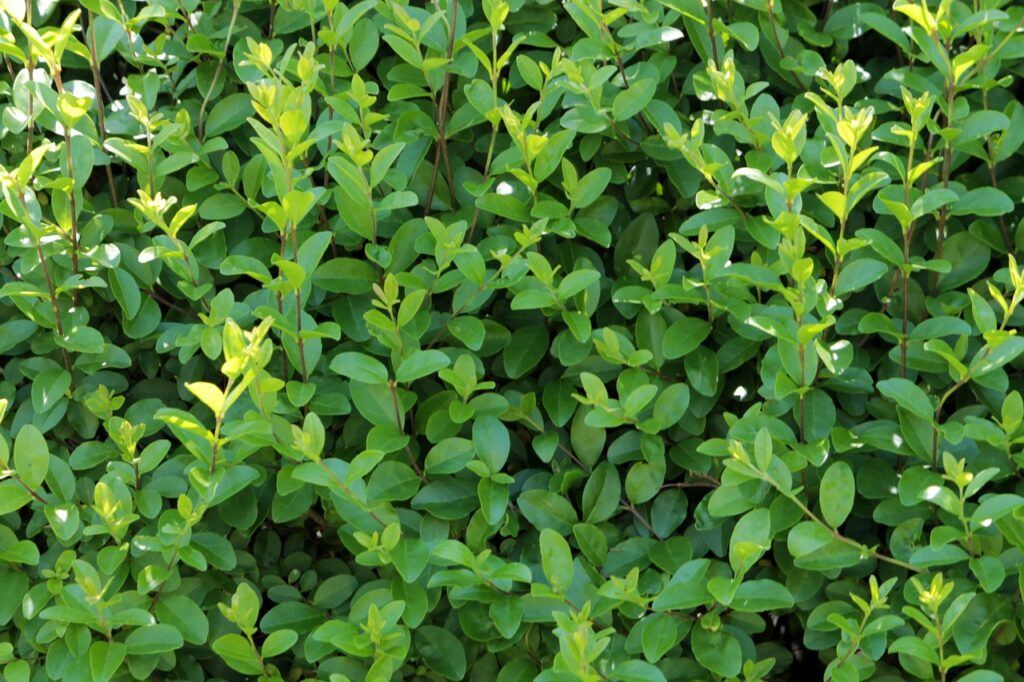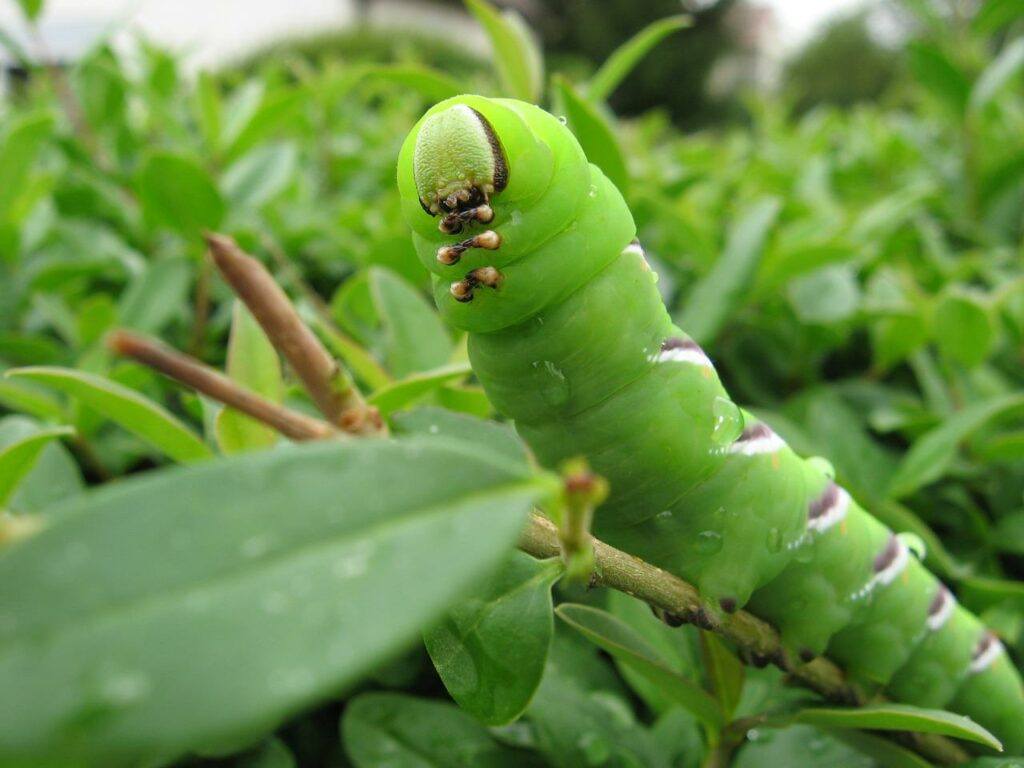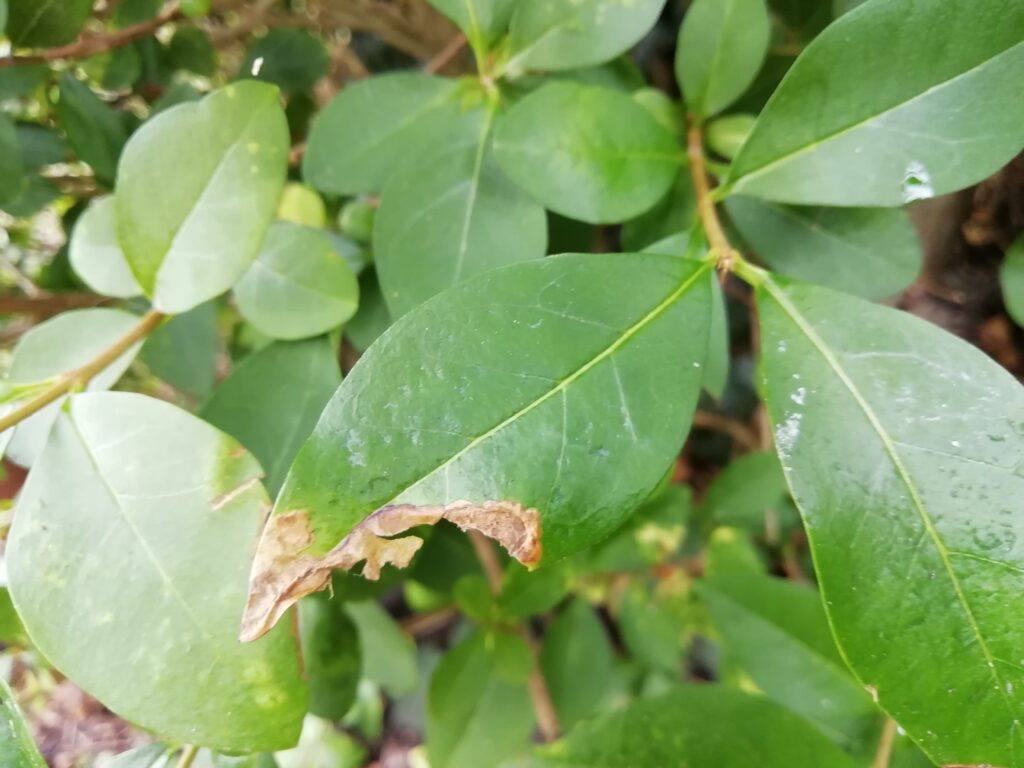Privet is very popular around the world as a boundary hedge.
It is actually a member of the Olive family.
Small clusters of white flowers arrive in spring, followed by small black berries that are inedible to humans but eaten by birds.
Privets can suddenly decline however, so if you have asked the question “Why Is My Privet Hedge Losing It’s Leaves?” then read on for answers and solutions.
Your Privet may be deciduous or affected by wind, snow or frost damage. Pests such as mites and caterpillars of the Privet Hawk Moth eat the leaves. Fungi such as Armillaria Root Rot “Honey Fungus”, Anthracnose Leaf Spot Fungus or Dematophora Root Rot can damage the foliage or root systems.
Your Privet May Be Deciduous
There are many species of Privet. Some originate in Asia, some in Australia and the UK has it’s own native species: Wild Privet.
Some may be fully evergreen, some are semi evergreen and some are deciduous and will naturally lose their leaves fully in the autumn and winter months.
- If your Privet is losing it’s leaves during this time and re budding in spring then you may have a deciduous variety.
- European or Common privet (Ligustrum vulgare) can be semi evergreen or deciduous. The leaves are oval in shape and dark green.
- Border privet (Ligustrum obtusifolium) is native to Asia. This variety is deciduous and has green leaves that are longer and finer than other Privets, these can turn darker to purple in the autumn before falling.
- If the plant looks otherwise healthy then this is simply the natural rhythm of the plant.

Wind, Snow or Frost Damage
For semi evergreen privets to retain their leaves through winter the temperatures need to be mild.
In colder regions many varieties of Privet that are semi evergreen will also drop their leaves in autumn and winter.
If the weather is extremely cold then parts of the Privet may die.
This presents as large areas of brown brittle stems with no leaves.
Heavy snowfall can collect on the Privet, weigh it down and damage the leaves.
How To Fix:
- To prevent severe frost, snow or wind damage consider covering your privet with sacking or fleece.
- If snow does collect on top then remove it regularly.
- Provide the plant with water and mulch in the autumn to provide some hydration and strengthen it’s defences through the winter.
- Check the damaged stems of your Privet by scraping back a small section of bark.
- If there is strong green tissue underneath then it is possible the plant can regrow buds.
- In this case leave the Privet to see if it recovers in the spring.
- If there is no green tissue and just dry brown twigs that snap, then these sections are probably dead and should be removed in the spring.
- If the whole Privet has been affected then in the spring cut it back to just above ground level.
- The roots tend to be hardier and there is a good chance they will push out new rejuvenated growth.

Pests: Mites
There are two common types of mite that can feed on your Privet plant or hedge.
The Privet Mite and the Privet Rust Mite both feed on the underside of leaves by sucking the sap from the leaf tissue.
Both mites are very small so it is unlikely you will see the mites themselves – just their effects.
This shows as leaves curling downward and becoming yellow or brown at the edges.
Sometimes pitting can be seen on the underside. Leaves can then fall.
The Privet then loses strength and growth slows.
How to fix:
- If you spot the signs above then if possible remove and quarantine any infected plants.
- Use Neem Oil to spray the plant, especially the underside of leaves. Do this every few days for a couple of weeks.
- Wash and sterilise your hands, pots and any tools you have been using on or near the plant.
- Remove and dispose of debris or fallen leaf matter around the base of the plant.
- Do not put in the compost as mites will likely be on this material.
Pests: Caterpillars of the Privet Hawk Moth
These caterpillars can eat the leaves of the Privet but are usually found in low numbers and as such do not cause too much damage.
The Privet Hawk Moth or Sphinx Ligustri has the widest wingspan of any moth in the UK.
How to fix:
- If you do find these on your Privet then no action is required unless the plant is very young and a large percentage of the leaves are being eaten.
- Then you can just pick them off and move them elsewhere.

Fungus: Wilt
This is a form of fungus that travels through the soil.
It enters the plant through the root system and travels up through the vascular system.
It shows as curling leaves that turn red to brown, and if the bark is peeled back you will see dark stains as stripes within the stem material.
How to fix:
- Unfortunately Wilt is difficult to cure.
- It is recommended to apply a fertilizer that is low in nitrogen and high in potassium, this may help.
- Remember to thoroughly sterilise all pots and tools that have been in contact with the Privet.
- If the plant is beyond saving it is best to remove it entirely including all roots and dispose (not in the compost heap).
- Don’t plant Privet or other susceptible hedge plants again in that spot. You could try a Conifer – they are immune to Wilt.
Fungus: Anthracnose Leaf Spot Fungus
This can occur after heavy rain in the spring and seems to affect mostly new growth.
It presents as small brown dead patches on the leaf that then become ragged holes.
The fungus can also travel to the wooden parts of the Privet and cause cankers – areas of dead tissue.
These can swell and disrupt the growth further down the stem.
How to Fix:
- Anthracnose Leaf Spot Fungus needs wet conditions to thrive so an extended dry period of weather should stop it in it’s tracks.
- If you see the signs above then prune out infected parts of the plant and dispose (not on the compost heap).
- Maintain good ventilation in and around the Privet by clearing debris from the base and pruning inside the canopy to create an open and airy structure.
- If you follow these steps the Privet is usually able to recover well.

Fungus: Armillaria Root Rot “Honey Fungus”
Another fungus that is spread through the soil, Armillaria Root Rot or “Honey Fungus” can be identified by the rhizomorphs or “boot laces” that are the fungal black root like structures that run through the soil.
There are also sometimes honey coloured mushrooms at the base of the plant in autumn, although these are not always present.
There will be white fungal matter between the bark and the stem, usually starting at ground level.
This is accompanied by a strong mushroom smell and the bark may split and rot.
Affected plants become stunted with small leaves and slow growth.
The Privet will then start to die back as the roots and base become compromised.
How to fix:
- Unfortunately there is no cure for Armillaria Root Rot “Honey Fungus”.
- Prevention is better than a cure so avoid creating overly moist soil conditions and maintain good airflow around the base.
- Monitor irrigation levels and use clean compost and mulch from verifiable sources.
- If your Privet is infected then it is best to remove it entirely including the roots.
- Dispose of all infected material (not in the compost heap).
- Till the surrounding soil to break up the rhizomorphs.
- Consider adding a barrier in the soil (pond liner or similar) to stop it spreading if you have other vulnerable plants in the area.
Fungus: Dematophora Root Rot
This type of fungus is characterised by a white candyfloss web like mycelia that grows on and under affected bark, usually at the base of the tree or shrub.
It can also be found in the soil and around the roots, although there is no accompanying mushroom smell.
As more branches become infected whole sections of the plant can die.
This fungus travels through the soil and can infect other plants.
How to fix:
- There is no cure for Dematophora Root Rot so prevention is best.
- Most fungi thrive in moist conditions so do not water excessively.
- If you do see the signs then it is best to remove the plant entirely including the roots.
- Dispose of all infected material (not in the compost heap).
- It is then recommended to replace the soil to ensure there is no subsequent infection.
Final Thoughts
Privets are actually quite hardy in their favoured conditions of mild temperatures and well drained soil.
The small green leaves provide a strong and solid screen that can be neatly shaped.
As hedges, they are perfect boundary plants like the Laurel tree.
By keeping an eye on soil moisture levels you can avoid many of the fungi mentioned above.
When shaping your Privet, don’t go for a flat top but rather a graduated “house roof” shape.
This increases ventilation which again will promote plant health and strength, enabling it to fight off disease and infestations.
Consider cutting back to the ground every five years or so to rejuvenate it.
If you have any different issues with your Privet that I have not covered above then drop a comment below and I will do my best to help.


Hi my pivot hedge has gone brown ,on only one side , the front side is alive and looks well
Hi Kevin,
Thanks for your query. Is the brown side the side that takes most of the prevailing wind? I have seen a few instances this year of shrubs and hedges that following strong winds in cold or hot weather, have begun to lose leaves on that side. That could be a reason as the wind strips the moisture from the leaves and they fall, revealing the brown twiggy interior of the hedge. If so, as the privet rehydrates things should improve. If the small outer branches still have green under the bark then this is a good sign. If the damage is more severe and affects whole branches and sections have become dry, brown and brittle – then you may have a fungus that has taken hold in the wet weather. If the damage seems to be getting worse and spreading, check to see if there are black “bootlaces” running though the soil around the roots of the privet. Is so there could be Honey Fungus present. If this is the case it is best to remove affected plants and dispose of them, and consider installing a barrier under the soil to stop it spreading further. Hopefully it is the first case scenario!
All the best,
Sue at My Garden Heaven